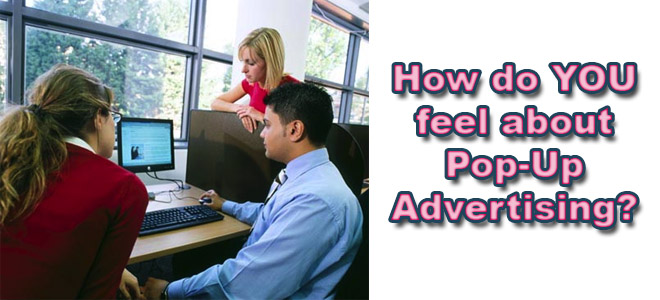
The American Association of Online Retailers reported last week that We the People actually enjoy pop-up adds! Insane you say? Perhaps not.
In a lightly attended press conference Mitch Engle, senior research designer at Nielsen, presented the findings that Americans, more than any other people group, respond favorably to online pop-up advertising.
“We took a different approach to collecting data this time around.” Engle said, “In most of these types of studies people are presented with advertising that matches their online behavior and preferences as closely as possible. For the purposes of this study we presented people with an average of ten adds that had no connection to their online behavior for every one pop-up that had a connection.”
The results were astounding.
“What we found was that, over time, people actually started to click through adds that had no connection whatsoever to what their normal online behavior had previously revealed.”
The study also showed that time of day seemed to make a difference.
“We found that at those times when regular online activity, reading blog posts, checking Pinterest boards, Tweeting etc. we’re at a lower ebb people tended to click through one off adds more frequently.”
When asked why he thought this was the case Engle had a ready answer.
“Americans are enamored with their online “communities”. Their online relationships offer a sense of control that just isn’t present in real life and so more and more people are spending more and more time in this controlled environment. This provides a real boon for advertisers because when a shopper feels that they are in control of the experience they are more likely to buy.”
Recent changes to Facebook helped accelerate and confirm results
“When Facebook went public we really had a chance to start hitting people more frequently with adds. We put them in their newsfeed, we put them in the margins more often and even started popping them up in games and other apps.”
But aren’t most of us annoyed by these pop-ups? Not according to Engle.
“The average Facebook user is in their late 30’s, has a little over 200 friends and typically uses the online platform to send private messages. That means that when they’re online checking and have nothing new to read, either in terms of status or messages they hang around to see if something “pops-up” (pun intended). At those off times of the day we can hit them with adds that are completely nonsense to them and, after an acclimation period, they’ll start to click through them. The click through to purchase rate is well over 35%”
But what about people in other countries?
“The research seems to indicate that people in other countries view their online relationships as being mush less critical to their daily lives. I’m not a social theorist, nor was that the intent of this study, but if I had to guess I’d say people in other countries tend to get out more. Going out to dinner in, say, Italy or Brazil is a five or six hour affair. In the States people are in and out.”
So what does this mean for us, the online consumer?
“Well”, said Engle, “if the shoes fits someone is going to sell it. People are buying from adds with no connection at a greater than 35% rate so we can probably expect more and broader advertising to encumber our online experiences.”
Oh great.
What do you think? Do these findings make sense to you?
Check out the full results of the study at:
Ohmygoshyoubelievedthatonaprilfoolsday.com







